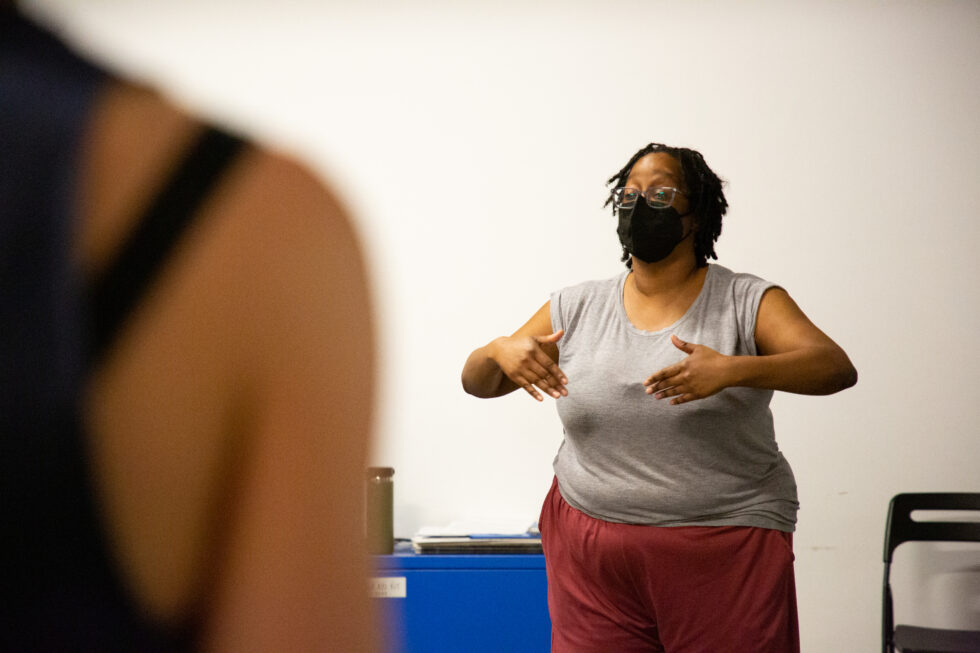How We Move Offers a New Kind of Intensive Designed for Disabled and Multiply Marginalized Artists
In recent years, the dance world has grown and changed “in really cool ways,” says India Harville, the founder and executive director of disability justice performing arts organization Embraced Body. “We’re seeing more BIPOC dancers, and fat dancers, and queer dancers, and Disabled dancers.”
What’s still missing, according to Harville, is the acknowledgment that many artists, like herself, exist across several of these identities at once. “A lot of times, you’ll be in one space designed for disabled bodies that won’t have awareness around race,” she says. “Or you’ll be in a space that’s queer-friendly but doesn’t have a politic around fatness.”
With How We Move, a new intensive for dancers 18 and older, Harville and her collaborators hope to create a space where Disabled, multiply marginalized artists can find community, agency, and creative power. Those collaborators include Kayla Hamilton, a performing artist and the artistic director of Circle O, a cultural organization aimed at uplifting multiply marginalized creatives; JJ Omelagah, a sound artist and the program director and access doula for Embraced Body; and New York City studio Movement Research. Funded by the Mellon Foundation, How We Move will begin with virtual sessions in March and May, followed by a 10-day in-person intensive in New York City in June, then a final virtual weekend in August.
“We’re interested in what happens when we bring multiply marginalized artists from the margins into the center, define our own spaces, and explore how we move together,” says Harville. “That’s really the creative question behind the work.”

How We Move is the result of many years of research, says Harville. “We’ve all had opportunities to explore some of these concepts together in other places,” she says. “Now we’re taking what we’ve learned collectively and putting it into this program, and the people who come through the program will also contribute to that knowledge base. It’s community work and collaborative work.”
One way that How We Move is designed to be truly accessible: Not only will the accepted participants have their travel, housing, and food costs fully covered (funds are also available to cover those artists traveling with Personal Care Attendants), but each will also receive a $2,000 stipend. “That felt really important, because multiply marginalized folks are often really hustling to survive, and that can make it difficult to make art,” says Harville.
How We Move will be shaped for and with its six participants—chosen from a round of applications in October—during the virtual sessions. “Multiply marginalized folks aren’t always afforded a lot of agency, so we really want to let the invited dancers choose their own adventure and build something,” says Harville.
For this reason, many of the specifics of the intensive are still to be solidified. But Hamilton says it’ll likely include classes, workshops, or experiences offered by the participants themselves; breaking bread together and community-building; and classes taught by non-Disabled dance artists, followed by feedback sessions on how they can make their classes more accessible.
Unlike intensives that value applicants’ resumé credentials or performance videos, How We Move will prioritize artists who are curious and eager to build a community of Disabled dancers. “Historically, there have been a lot of intensives that require that you have performed on a particular kind of stage or had a particular kind of experience,” says Harville. “Sometimes multiply marginalized dancers don’t have easy access to that.”
The collaborators are planning a second cohort of How We Move for 2026, which they hope will be open to international artists and include more participants. “One of the main impacts I want to see out of this program is a stronger network of Disabled dancers who recognize their brilliance and feel empowered to bring their contribution to the dance world in a bigger way, with more support underneath them,” says Harville. “I hope this program spawns others like it, and that there’s a larger-scale change in the dance world so that including multiply marginalized dancers becomes the norm.”
The post How We Move Offers a New Kind of Intensive Designed for Disabled and Multiply Marginalized Artists appeared first on Dance Teacher.